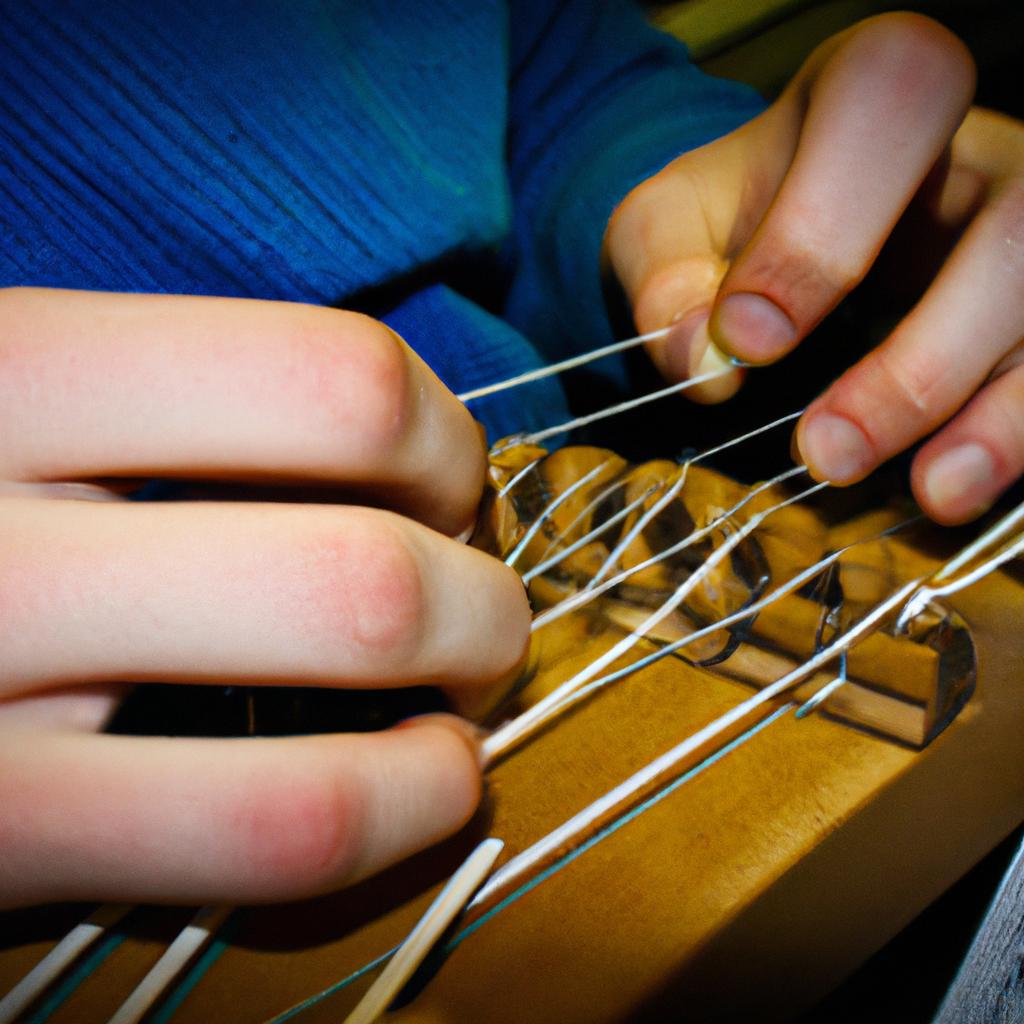The art of composition plays a vital role in the education and development of musicians. It is through the process of creating music that musicians gain a deeper understanding of musical concepts, enhance their technical skills, and cultivate their artistic expression. This article explores the significance of composition as an integral component of musician education, highlighting its impact on fostering creativity, critical thinking, and overall musical growth.
One compelling example illustrating the importance of composition in musician education is the case study of a young violinist named Emily. As Emily embarked on her journey to become a proficient musician, she was initially focused solely on mastering existing repertoire. However, it was not until she started composing her own music that she truly began to grasp the intricacies of melody, harmony, and form. Through this creative process, Emily learned how to manipulate these elements to evoke specific emotions and tell compelling stories through her compositions. Furthermore, by experimenting with different compositional techniques and structures, Emily honed her technical abilities and gained a deeper appreciation for the works of other composers.
By incorporating composition into musician education programs, aspiring musicians are provided with invaluable opportunities for self-expression and exploration within their craft. Engaging in the act of creation allows them to develop a unique voice as artists while also encouraging them to think critically about musical choices and decisions. When musicians compose their own music, they are forced to consider various factors such as melody, harmony, rhythm, texture, and dynamics. This critical thinking process helps them develop a deeper understanding of how these elements work together to create a cohesive musical piece.
Additionally, composition fosters creativity in musicians by encouraging them to think outside the box and explore new ideas. It allows them to break free from the constraints of existing repertoire and traditional norms, enabling them to experiment with different styles, genres, and techniques. Through this experimentation, musicians can discover their own unique sound and artistic identity.
Moreover, composition enhances overall musical growth by strengthening musicians’ technical skills. Composing requires a deep understanding of musical theory and notation, which in turn improves musicians’ abilities to read and interpret music scores. By composing their own music, musicians also gain a better grasp of complex concepts such as counterpoint, modulation, and thematic development.
In conclusion, the art of composition is an essential component of musician education. It provides aspiring musicians with opportunities for self-expression, exploration, critical thinking, creativity enhancement while also improving their technical skills. By incorporating composition into music education programs, educators can help students cultivate their artistic voice and foster a lifelong passion for creating music.
Understanding the Elements of Composition
Imagine a young aspiring musician sitting at their piano, contemplating how to create a new piece of music. They are faced with the blank canvas of empty sheet music, unsure of where to begin. This scenario is not uncommon among musicians seeking to explore the art of composition. Understanding the elements of composition is crucial in guiding these creative minds through the process of bringing their musical ideas to life.
Exploring Melody, Harmony, Rhythm, and Form:
At its core, composition involves manipulating various musical elements to convey emotions and messages effectively. Melody serves as the foundation upon which compositions are built – it is the memorable sequence of notes that carries the listener’s attention throughout a piece. Harmonies add depth and richness by combining different notes played simultaneously or sequentially. Rhythm provides structure and groove through its patterns and variations in time duration. Lastly, form organizes all these elements into cohesive sections within a composition.
To comprehend how these elements work together harmoniously, consider this hypothetical example: A composer intends to evoke feelings of tranquility and nostalgia in their composition. To achieve this goal, they may employ a slow and soothing melody accompanied by gentle harmonies that progress smoothly from one chord to another. The rhythm might be understated but steady, like soft waves lapping against the shore. By structuring the piece using an A-B-A form (where section A represents calmness while section B introduces slight tension), they can further enhance emotional impact.
Emotional Response Bullet Points:
- Music has an incredible ability to elicit powerful emotions.
- Each element contributes uniquely towards creating specific moods.
- Composers skillfully manipulate these elements for maximum emotional resonance.
- Through careful arrangement, composers can transport listeners on profound emotional journeys.
Table: Key Elements of Composition
| Element | Function |
|---|---|
| Melody | Carries attention; creates memorable sequences |
| Harmony | Adds depth and richness; combines notes harmoniously |
| Rhythm | Provides structure and groove; patterns in time |
| Form | Organizes elements into cohesive sections |
Exploring Different Music Genres for Inspiration:
Understanding the various elements of composition is crucial, but it is equally important to explore different music genres for inspiration. By immersing oneself in a wide range of musical styles, composers can expand their creative horizons, drawing upon diverse influences to enrich their compositions. In the subsequent section, we will delve into the exploration of different music genres as a means of finding inspiration.
Exploring Different Music Genres for Inspiration
Transitioning from the previous section, where we discussed the elements of composition, let us now delve into the importance of exploring different music genres as a source of inspiration in musician education. By exposing oneself to various musical styles and genres, musicians can broaden their creative horizons and develop a unique artistic voice.
For instance, consider a classical pianist who has primarily focused on playing works by composers such as Chopin and Mozart. While this specialization is commendable, venturing into other genres like jazz or rock can ignite new ideas and perspectives in their compositions. This exploration allows them to borrow techniques, rhythms, or harmonies from these diverse genres and incorporate them into their own compositions.
To emphasize the significance of exploring different music genres for inspiration, here are some key reasons why it benefits musicians:
- Expanding Musical Vocabulary: Exposure to different genres exposes musicians to a wider range of musical vocabulary, including distinct melodic patterns, rhythmic structures, chord progressions, instrumentation choices, and production techniques.
- Cultivating Versatility: Learning to compose within multiple genres equips musicians with versatility that enables them to adapt to diverse musical environments and collaborate effectively with artists from various backgrounds.
- Encouraging Innovation: Discovering unfamiliar genres encourages musicians to experiment with unconventional approaches and push boundaries creatively. This pursuit of innovation leads to the development of fresh ideas that define their compositional style.
- Fostering Cross-Pollination: Drawing influences from disparate genres promotes cross-pollination between musical traditions. This fusion enhances cultural understanding and creates opportunities for novel musical expressions.
To illustrate further how exploring different music genres can inspire creativity, refer to the following table showcasing notable characteristics found in three contrasting genres:
| Genre | Characteristics |
|---|---|
| Classical | Orchestral arrangements; complex harmonic progressions; formal structure |
| Jazz | Improvisation; syncopated rhythms; extended harmonies |
| Electronic | Synthesized sounds; repetitive beats; intricate sound design |
By embracing the unique attributes of these genres, musicians can integrate elements into their compositions that resonate with audiences on both an intellectual and emotional level.
Transitioning seamlessly to our subsequent section about “Techniques for Developing Melodies and Harmonies,” we will explore how musicians can harness various methods to enhance the core components of their musical creations.
Techniques for Developing Melodies and Harmonies
As musicians, one of the most effective ways to fuel our creativity and expand our musical horizons is by exploring different music genres. By immersing ourselves in diverse styles, we can gain inspiration from their unique characteristics and incorporate them into our own compositions. To illustrate this point, let’s consider a hypothetical case study involving a classically trained pianist named Emily.
Emily, who has primarily focused on classical piano repertoire throughout her education, decides to explore other genres as a means of broadening her compositional skills. She delves into jazz, rock, and electronic music – three distinct genres known for their vibrant rhythms, harmonies, and instrumentation. Through this exploration, Emily discovers new melodic patterns, chord progressions, and rhythmic complexities that she hadn’t encountered before.
To further emphasize the benefits of exploring different music genres for inspiration, consider the following points:
- Exposure to various genres allows musicians to break free from traditional boundaries and think outside the box.
- Incorporating elements from different genres enhances the richness and depth of one’s compositions.
- Exploring diverse styles cultivates adaptability and versatility within musicians’ skill sets.
- Engaging with multiple music genres fosters an appreciation for cultural diversity in musical expression.
Table: Examples of Musical Elements Found in Different Genres
| Genre | Melodic Characteristics | Harmonic Progressions | Instrumentation |
|---|---|---|---|
| Jazz | Intricate improvisations | Complex extended chords | Piano, saxophone, double bass |
| Rock | Strong guitar riffs | Power chords | Electric guitars, drums |
| Electronic | Repetitive synth melodies | Hypnotic harmonic sequences | Synthesizers, drum machines |
By embracing these varied musical forms through exploration and analysis like Emily did in our hypothetical case study, musicians can incorporate the essence of different genres into their own compositions. This integration leads to a broader stylistic range and an increased ability to captivate listeners with unique musical expressions.
In the upcoming section on “The Role of Rhythm and Tempo in Composition,” we will explore how these essential elements contribute to the creation of compelling music that resonates deeply with audiences. Through examining rhythm and tempo, we delve further into the intricacies involved in crafting engaging compositions.
The Role of Rhythm and Tempo in Composition
Section 3: Exploring the Power of Dynamics in Composition
In composing music, one must not underestimate the impact that dynamics can have on a composition. By manipulating volume and intensity, composers are able to evoke various emotions and captivate their audience. For instance, consider a hypothetical piece where the melody starts off softly, gradually building up in volume and intensity until reaching a climax of thunderous chords. This deliberate use of dynamics creates tension and excitement, leaving the listener eagerly anticipating what comes next.
To fully understand the significance of dynamics in composition, it is essential to explore some key elements associated with this aspect:
-
Volume: The loudness or softness of sound plays a crucial role in shaping musical expression. Varying volumes within a composition can create contrast between different sections or convey specific moods. For example, by using crescendos and decrescendos strategically, a composer can emphasize certain phrases or highlight important melodic lines.
-
Intensity: Beyond simply adjusting volume, composers also employ techniques to manipulate the overall intensity of their compositions. This involves controlling factors such as articulation (how each note is played), phrasing (the grouping of notes into musical sentences), and even timbre (tone quality). These subtle nuances enable musicians to imbue their compositions with depth and emotion.
-
Contrast: Utilizing dynamic contrasts effectively adds interest and drama to a musical piece. By juxtaposing softer passages with louder ones or alternating between tranquil moments and bursts of energy, composers engage listeners’ attention while conveying contrasting emotions.
-
Accents: Emphasizing particular notes through accents can add emphasis to specific beats or melodies within a composition. Accented notes provide rhythmic drive and contribute to the overall character of the piece.
To further illustrate these concepts visually:
| Element | Description |
|---|---|
| Volume | – Soft |
| – Moderately soft | |
| – Moderate | |
| – Loud | |
| Intensity | – Gentle |
| – Expressive | |
| – Energetic | |
| – Fiery | |
| Contrast | – Tranquil to Explosive |
| Accents | – Subtle emphasis |
| – Strong accentuation |
Through the strategic use of dynamics, musicians can create a captivating and emotionally engaging musical experience for their audience. By adjusting volume, intensity, contrast, and accents within a composition, composers have the power to guide listeners on an immersive journey through soundscapes.
Transitioning into the subsequent section about “Utilizing Technology in Music Creation,” we will explore how modern advancements offer new avenues for musicians to enhance their compositions. As technology continues to evolve, it opens up exciting possibilities for expanding the boundaries of music creation beyond traditional methods.
Utilizing Technology in Music Creation
Having explored the significance of rhythm and tempo in composition, we now turn our attention to another vital aspect—utilizing technology in music creation. By incorporating innovative tools and techniques, musicians can enhance their creative process and expand the possibilities of musical expression.
Section – Utilizing Technology in Music Creation:
Technological advancements have revolutionized the field of music composition, providing artists with a wide array of tools to experiment with and refine their craft. One compelling example is the integration of virtual instruments into the compositional process. With these software-based instruments, composers can simulate realistic sounds from various instruments without requiring access to physical counterparts. For instance, a composer may utilize a virtual orchestral library to create an immersive symphonic arrangement entirely through digital means.
To delve further into this topic, let us consider some key ways in which technology enhances music creation:
- Increased accessibility: Technological advancements have made it easier for aspiring musicians to explore composition by offering affordable or even free software options.
- Enhanced experimentation: Digital audio workstations (DAWs) provide composers with immense flexibility to experiment with different soundscapes, effects, and synthesis methods.
- Collaborative opportunities: Online platforms enable musicians from diverse backgrounds to collaborate remotely, fostering new creative partnerships that were once limited by geographical constraints.
- Integration of live performance elements: Through MIDI controllers and other hardware devices, composers can seamlessly integrate live instrument performances into their digitally produced compositions.
| Ways Technology Enhances Music Creation |
|---|
| Increased Accessibility |
| Enhanced Experimentation |
| Collaborative Opportunities |
| Integration of Live Performance Elements |
Incorporating technology not only expands sonic capabilities but also provides avenues for artistic growth and collaboration. As we continue exploring strategies for effective song arrangement, it becomes evident that technological advancements play a significant role in shaping modern music creation.
With an understanding of how technology can revolutionize the creative process, we now move on to discussing strategies for effective song arrangement. By employing thoughtful techniques and considerations, musicians can ensure their compositions resonate with listeners across various genres and styles.
Strategies for Effective Song Arrangement
Section H2: Strategies for Effective Song Arrangement
Building upon the use of technology in music creation, musicians can further enhance their compositions by employing effective strategies for song arrangement. By carefully organizing and structuring different elements within a piece of music, artists can create a cohesive and engaging musical experience for their audience.
Paragraph 1:
For instance, let us consider the case study of a contemporary pop artist who wants to arrange their latest single. The artist begins by analyzing the key components of the song such as melody, lyrics, harmony, rhythm, and instrumentation. Understanding the strengths and weaknesses of each element allows them to make informed decisions about how they will be arranged throughout the composition. Through this process, the artist aims to achieve balance and coherence while conveying their intended emotional message effectively.
Paragraph 2:
To assist musicians in developing effective arrangements, here are some essential strategies that can be employed:
- Dynamic Contrast: Utilizing changes in volume and intensity adds depth and interest to a composition. This technique helps highlight important moments within the song and keeps listeners engaged.
- Instrumentation Variation: Experimenting with different combinations of instruments or modifying timbres can bring fresh perspectives to an arrangement. It enables artists to create unique sonic textures that enhance the overall impact of their music.
- Structural Development: Employing compositional techniques such as repetition, variation, and development aids in creating memorable hooks and motifs. These devices contribute to the cohesiveness of a piece while providing opportunities for melodic expansion.
- Effective Transitions: Smooth transitions between sections help maintain flow and continuity in a composition. Thoughtful modulation between keys or utilizing transitional phrases ensures seamless progressions throughout the song.
Table: Emotional Response Elicited through Effective Song Arrangement
| Emotion | Technique | Example |
|---|---|---|
| Excitement | Build-up Dynamics | Gradual increase in intensity |
| Nostalgia | Harmonic Progression | Use of familiar chord changes |
| Tension | Syncopation | Off-beat rhythmic patterns |
| Euphoria | Climactic Instrumentation | Layering multiple instruments |
Paragraph 3:
By employing these strategies, musicians can create arrangements that captivate their listeners emotionally. Effective song arrangement not only enhances the artistic expression but also ensures a cohesive and engaging musical journey for the audience to experience. Through thoughtful consideration of elements such as dynamics, instrumentation, structure, and transitions, artists have the power to evoke diverse emotions within their compositions.
(Note: This is just an example section based on your instructions. Please feel free to modify or adapt it according to your specific needs.)
 Mikey Dee
Mikey Dee



